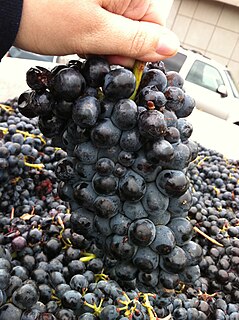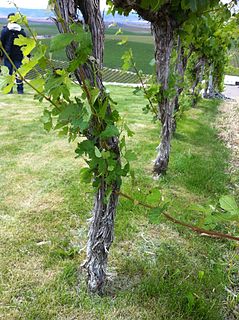
Nebbiolo is an Italian red wine grape variety predominantly associated with its native Piedmont region, where it makes the Denominazione di Origine Controllata e Garantita (DOCG) wines of Barolo, Barbaresco, Roero, Gattinara, Carema and Ghemme. Nebbiolo is thought to derive its name from the Italian nebbia or Piedmontese nebia, meaning "fog". During harvest, which generally takes place late in October, a deep, intense fog sets into the Langhe region where many Nebbiolo vineyards are located. Alternative explanations refers to the fog-like glaucous veil that forms over the berries as they reach maturity, or that perhaps the name is derived instead from the Italian word nobile, meaning noble. Nebbiolo produces lightly-colored red wines which can be highly tannic in youth with scents of tar and roses. As they age, the wines take on a characteristic brick-orange hue at the rim of the glass and mature to reveal other aromas and flavors such as violets, tar, wild herbs, cherries, raspberries, truffles, tobacco, and prunes. Nebbiolo wines can require years of aging to balance the tannins with other characteristics.

Barbera is a red Italian wine grape variety that, as of 2000, was the third most-planted red grape variety in Italy. It produces good yields and is known for deep color, full body, low tannins and high levels of acidity.
Freisa is a red Italian wine grape variety grown in the Piedmont region of north-west Italy, primarily in Monferrato and in the Langhe, but also further north in the provinces of Turin and Biella. Freisa is a vigorous and productive vine whose round, blue-black grapes are harvested in early October. The three-lobed leaves are relatively small and the bunches are elongated in form. By the 1880s it had become one of the major Piedmontese grapes, and in that period its cultivation was stimulated by the vine’s resistance to the downy mildew caused by the Plasmopara viticola fungus. Wines made from the Freisa grape are red and usually somewhat sweet and lightly sparkling, or foaming. Still and fully sparkling versions are also produced, however, as are dry and more decidedly sweet styles. In the Canavese there is also a rosé which can be made primarily from Freisa according to Denominazione di origine controllata (DOC) regulations.
Braquet is a red French wine grape variety grown predominantly in the Provence region of southeastern France, particularly in the Bellet Appellation d'origine contrôlée (AOC) where it is as both a blending and varietal grape in still and rosé wines. Also known as Brachet, the vine produces naturally low yields and light bodied wines that are delicately perfumed. Recent thought among ampelographers is that Braquet is not related to the more aromatic Italian wine grape of the Piedmont region known as Brachetto.

Lombardia (Lombardy) wine is the Italian wine produced in the Lombardy region of north central Italy. The region is known particularly for its sparkling wines made in the Franciacorta and Oltrepò Pavese areas. Lombardy also produces still red, white and rosé wines made from a variety of local and international grapes including Nebbiolo wines in the Valtellina region, Trebbiano di Lugana white wines produced with the Chiaretto style rosé along the shores of Lake Garda. The wine region currently has 15 Denominazione di origine controllata (DOC), 3 Denominazione di Origine Controllata e Garantita (DOCG) and 13 Indicazione Geografica Tipica (IGT) designations. The main cities of the region are Milan, Bergamo and Brescia. The region annually produces around 1.3 million hectolitres of wine, more than the regions of Friuli-Venezia Giulia, Marche, Trentino-Alto Adige/Südtirol and Umbria.

Arneis is a white Italian wine grape variety originating from Piedmont, Italy. It is most commonly found in the hills of the Roero, northwest of Alba, where it is part of the white Denominazione di Origine Controllata e Garantita (DOCG) wines of Roero. It can also be used to produce DOC wines in Langhe. Arneis is so called because it is regarded as a somewhat difficult variety to grow. It is a crisp and floral varietal, and has been grown for centuries in the region. The white wines made from the Arneis grape tend to be dry and full bodied with notes of pears and apricots.
Uva Rara is a red Italian wine grape variety that is grown in the Piedmont and Lombardy wine regions of northern Italy. The grape is a permitted blending variety along with Nebbiolo in the Denominazione di Origine Controllata e Garantita (DOCG) wines of Ghemme. In the Denominazione di Origine Controllata (DOC) wine region of Oltrepò Pavese the grape is often blended with Barbera and Croatina. While Uva Rara's name means "rare grape" in Italian, the variety is actually widely planted with 608 hectares of the vine recorded in Italy in 2000.
Vespolina is a red Italian wine grape variety that is planted in Piedmont around Gattinara and Ghemme. Ampelographer believe that the grape is most likely indigenous to this area of Piedmont and recent DNA profiling identified a parent-offspring relationship with Nebbiolo. Outside Piedmont it is found in the Lombardy region of Oltrepò Pavese where the grape is known as Ughetta. In Gattinara, Vespolina is sometimes blended with Nebbiolo and Bonarda Piemontese. Unlike the white Italian grape Vespaiolo, the root of the name Vespolina does not have a direct connection with vespe or wasp. However the true origins of the name are still unclear.
Brugnola is a red Italian wine grape variety that is grown in the Lombardy wine region of Valtellina. While historically, Brugnola was thought to be a local synonym for Emilia-Romagna wine grape Fortana, DNA analysis has shown that the two grapes are distinct variety and that, instead, Brugnola shares a close genetic relationship with the Piedmont wine grape Nebbiolo.
Pollera nera is a red Italian wine grape variety that is grown primarily in the Liguria wine region and northwest Tuscany. Ampelographers believe that the vine has a very long winemaking history but it is rarely seen today. It is believed to have been descended from the Chianti wine grape Mammolo and the Corsican wine grape Sciacarello which would make it a half-sibling of Colombana nera.
Rossignola is a red Italian wine grape variety that is grown in the Veneto wine region of northeast Italy. The variety was first mentioned growing in the province of Verona in the early 19th century and today is a permitted blending variety in several Denominazione di origine controllata (DOC) wines of the Veneto including Bardolino and Valpolicella.
Bracciola nera is a red Italian wine grape variety that is primarily found in the Liguria and Toscana wine regions of western Italy. The only Denominazione di origine controllata (DOC) that Bracciola nera plays a significant role is in the Colli di Luni DOC of Ligura where the grape is permitted to be blended with Sangiovese, Canaiolo, Pollera nera, Ciliegiolo, Vermentino nero and other varieties. A late-ripening variety, Bracciola nera usually contributes acidity to blends.
Colombana nera is a red Italian wine grape variety that is grown in Emilia-Romagna and Tuscany. Despite similarities in name, the grape did not get its name from nor is it grown in the San Colombano al Lambro region of Lombardy nor is it permitted in the Denominazione di origine controllata (DOC) wine of the same name. Rather, ampelographers believe that Colombana nera is named after the Abbey of San Colombano located in the commune of Bobbio in the Piacenza province of Emilia-Romagna where the grape has had a long history of cultivation.

Vermentino nero is a red Italian wine grape variety that is predominantly grown in province of Massa-Carrara in Tuscany. After World War II, the vine was almost lost to extinction until Podere Scurtarola, a producer from Massa, began replanting old vineyards with the grape. By 2000, there were 199 hectares of Vermentino nero growing in Italy with the grape authorized for production in the Denominazione di origine controllata (DOC) wines of Candia dei Colli Apuani and Colline Lucchesi.
Piccola nera is red Italian and Slovenian wine grape variety that is grown in the province of Trieste within the Friuli-Venezia Giulia wine region and across the border in neighboring Slovenia where ampelographers believe that the grape originated. Piccola nera, whose name means "little black", tends to produce to light bodied red and rosé wines that are meant to be consumed young. It is a permitted variety in the Denominazione di origine controllata (DOC) wines of Carso where it is usually blended with Terrano and in Venezia Indicazione geografica tipica IGT classification where the grape can be used to make varietal wines.

Rossolino nero is a red Italian wine grape variety that is grown in the Valtellina region of Lombardy in northern Italy. The grape was once thought to be a clone of Rossola nera but DNA profiling in the late 20th and early 21st century has shown that the two grapes are distinct varieties but are likely related. Around the village of Teglio, a pink-skinned color mutation of Rossolino nero exist that is known as Rossolino Rosa.
Avanà is a red Italian wine grape variety that is grown in the Piedmont wine region of northwest Italy. Historically, the grape has also been grown in the Dauphiné and Savoie wine region of eastern France where it was known as Hibou noir and in the Valais region of Switzerland. The grape is most often used as a blending variety in the Denominazione di origine controllata (DOC) zones of Pinerolese, with Barbera, Persan, Freisa and Neretta Cuneese, and Valsusa, with Barbera, Dolcetto, Neretta Cuneese and other local red Piemontese varieties.
Avarengo is a red Italian wine grape variety that is grown in the Piedmont wine region of northwest Italy where it is a permitted blending component in the Denominazione di origine controllata (DOC) wines of Pinerolese. Here the grape is usually blended with Avanà, Neretta Cuneese and other local red Piemontese varieties.
Barbera del Sannio is a red Italian wine grape variety that is grown in the Campania region of southern Italy. Despite the similarities in name and appearance, the grape has no close genetic relationship with the Piedmont wine grapes Barbera or Barbera bianca or the Sardinian wine grape Barbera Sarda and is, instead, more closely related to the Campanian varieties Casavecchia and Catalanesca and the Apulian grape Nero di Troia.
Bubbierasco is a red Italian wine grape variety that is grown in the province of Cuneo in the Piedmont wine region of northwest Italy. The grape is a natural crossing of the Nebbiolo grape, famous for the red wines of Barolo and Barbaresco, and Bianchetta di Saluzzo, a white grape variety that has been historically grown around the town of Saluzzo.







